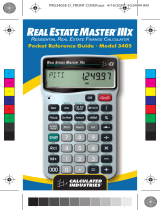
U
SER
’
S
G
UIDE
— 3
Recalling Tax and Insurance % Rates .......................................32
Setting Tax and Insurance $ ......................................................32
Calculating Tax and Insurance % or $ .......................................33
PITI Payment (Tax and Insurance Entered as %) .....................34
Total Payment (Including Expenses) and Interest-Only
Payment..................................................................................34
Estimated Income Tax Savings and “After-Tax” Payment .........35
Rent vs. Buy...............................................................................36
Adjustable Rate Mortgages........................................................37
ARM Payment — Worst-Case Scenario....................................38
ARM Payment — Using Lifetime Cap .......................................39
Decreasing ARM Payment.........................................................40
Increasing and Decreasing ARM Payment................................40
Amortization and Remaining Balance........................................41
Notes on Amortization................................................................41
Total Principal and Interest for a 30-Year Loan .........................42
Amortization List for Individual Year(s) —
Using “Next” Feature ..............................................................43
Amortization List for Individual Year(s) —
Using Month Offset.................................................................44
Amortization List for Individual Payment(s) ...............................45
Amortization List for a Range of Payments or Years.................46
APR and Total Finance Charges ...............................................47
Finding APR, Total Finance Charges
(Excluding Mortgage Insurance).............................................47
Prepaid/Odd-Days Interest and APR .........................................48
Balloon Payment/Remaining Balance Needed to Pay Off
a Loan.....................................................................................49
Bi-Weekly Loans ........................................................................49
Bi-Weekly Term Reduction and Payment ..................................50
Trust Deeds and Discounted Notes...........................................50
Purchase Price of a Note — Fully Amortized ............................51
Finding the Yield on a Discounted Note ....................................51
Finding the Value and Discount of a Trust Deed .......................52
BUYER QUALIFYING...................................................................53
QUALIFYING EXAMPLES............................................................54
Recalling Income/Debt Qualifying Ratios ..................................54
Storing New Income/Debt Qualifying Ratios..............................54
Finding Qualifying Loan Amount and Sales Price (Simple
Example Excluding Tax/Insurance).........................................55
Qualifying Loan Amount and Sales Price (Complete Example
Including Down Payment, Tax/Insurance, Monthly Association
Dues) ......................................................................................56
“Restricted” Qualifying ...............................................................57




























